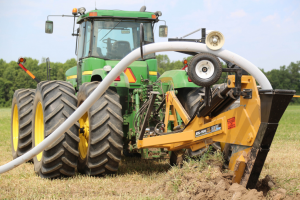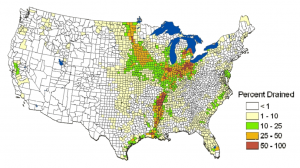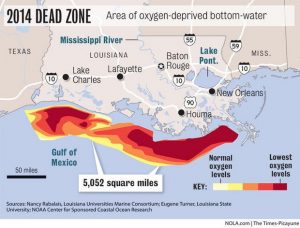8.4 Artificial Drainage
In some situations, the natural drainage capability of the soil is inadequate to meet the requirements of the intended agricultural or engineering uses for the land. Therefore, people invest substantial time, money, and resources to increase soil drainage rates by installing artificial drainage systems. One widespread type of artificial drainage is subsurface drainage, which in the US is commonly called tile drainage. That name derives from the clay tiles that were used to construct these underground drainage systems in the past. Now, subsurface drainage systems are constructed mainly from heavy-duty, corrugated, perforated plastic tubing. This tubing if often installed approximately 1.2 m below-ground using a large tractor and a special implement called a tile plow (Fig. 8‑5).

Subsurface drainage systems can remove not only excess water but also nutrients and pesticides from the soil. These compounds can negatively affect the water quality and aquatic ecosystems of the surface water bodies that receive the drainage water. One large-scale example is the hypoxic zone that occurs where the Mississippi River flows into the Gulf of Mexico. In this context, the hypoxic zone is defined as the region where the concentration of dissolved oxygen in the water at the sea floor is <2 mg L-1. At these low oxygen levels bottom-dwelling fish and shrimp cannot survive, so the hypoxic zone has also been called the “dead zone”.
Subsurface drainage systems have substantially increased the agricultural productivity of poorly-drained soils around the world. The increased drainage improves the soil’s ability to transport oxygen to crop roots to support cellular respiration. This allows crops to develop deeper and larger root systems, which enable higher yields. These agronomic benefits have driven broad adoption of this technology in areas with poorly-drained soils. The map in Fig. 8‑6 shows the percent of the total land area in each US county estimated to be artificially drained cropland [12]. Artificial drainage is estimated to affect >10% of the land area in many counties and >50% in some portions of the Mississippi River floodplain and the Midwest. Unfortunately, the agronomic benefits of these drainage systems often come with unintended ecological and environmental consequences.

Hypoxia develops when nutrient rich water flows into the Gulf enhancing the growth of algae and other organisms near the surface. When these organisms die and settle to the sea floor, bacteria decompose the dead organisms, consuming oxygen in the process resulting in hypoxia. The loss of nutrients, particularly nitrogen and phosphorus, from cropland in the Mississippi River basin is considered to be a major contributor to the growth in size of the hypoxic zone in the Gulf of Mexico since the 1980s (Fig. 8‑7). And, research has shown that artificial drainage systems have increased nutrient loss from cropland, making artificial drainage one contributing factor to this large-scale environmental problem.

Recognizing the potential environmental impacts of drainage is important, but it is also important to understand that drainage itself is not necessarily problematic. Redistribution of water within the soil profile and drainage of water from the soil profile are essential to the functioning of many natural and managed landscapes. These processes can help sustain plant growth, biogeochemical cycling, and groundwater aquifers. Redistribution and drainage also strongly influence the movement of solutes in the environment, and in the next chapter we will consider solute transport processes in more detail.

